Reno City Council returns this Wednesday, July 26th with some major decisions related to downtown revitalization. Now, I know that downtown is not a chief concern of all local residents, who may have felt alienated by it for years, maybe decades. Relative newcomers may have spent little if any time there, with the exception of a festival or parade. But the City has decided to devote some serious attention (and funds) to the former casino core with the intent of luring back not just tourists of various types, but residents, too. And they’re spending a lot of public money to do it.
What that means is that all residents should be helping to evaluate whether the decisions and funding being proposed are in the public interest. Do they truly represent steps that will accelerate the desired revitalization? Would the actions being contemplated by our City leaders help lure YOU downtown? Let them know!
Something that I’ve learned through studying Reno for 20+ years is that its downtown is like no other. Yes, of course, all cities have similarities. But the waxing and waning of downtown’s casinos has given it some unique challenges. Its gaming footprint has shrunk but consolidated. And we haven’t yet figured out how to integrate what remains of it into a thriving, walkable urban ecosystem. What other businesses can succeed in a space where major chunks of property are devoted to inward-facing casino resorts? What other endeavors are compatible with the environment they have created and perpetuate?
Strategies imported from other cities can be promising, but some don’t make sense applied to this specific context. That’s why it’s important not just to follow “best practices” but to closely examine how each would play out in this particular space.
Looking at some of this week’s agenda items, I have two overarching concerns: one is whether the Council has all the information it needs to make informed decisions. And the other is whether some of the initiatives being proposed constitute the most responsible use of public funds as opposed to potentially more effective alternatives. Revitalizing the core is going to take a lot of coordinated, incremental steps, and it’s essential that each step is carefully calibrated to get things moving in the right direction, in the proper order. So I’d like to offer some thoughts to help Council and the rest of us think through some of these consequential decisions.
PKWY Tavern at Reno City Center
First off, appearing on Wednesday’s consent agenda (Items B. 4 and B.5) are requests to license gaming and alcohol at the PKWY Tavern, which according to the Reno Gazette-Journal, could open on the ground floor of Reno City Center this fall.
One problem I immediately see with this item is a troubling lack of specificity, plus some conflicting information. As the staff report indicates, the Nevada Gaming Commission just approved a license for PKWY Tavern to operate 197 slot machines last month. That number alone took me by surprise. Council’s last action regarding this property was on March 10, 2021 (Item B.1.a.3.), when they approved a temporary license for just 16 slots, intended to allow the applicant to keep the gaming license active. It was approved back then on the consent agenda with no discussion and certainly no indication of future intent to apply for twelve times as many slots.
So what’s going on here? The address provided for the license is 219 University Way, but Reno City Center as a whole uses that address, so precisely where on that massive property would these slots be located? The staff report describes the site as “the northwest corner of University Way and West 2nd Street” (they meant East 2nd Street). But the Vicinity Map associated with both the alcohol and gaming license identifies the “Business Location” as the small red hatched rectangle below, with the only entrance on University Way, approximately below the skyway. But that can’t possibly be right. You couldn’t even fit 197 slot machines in that limited area.
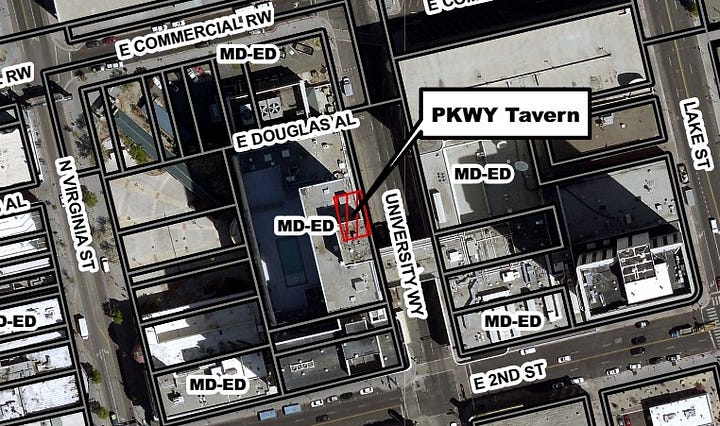
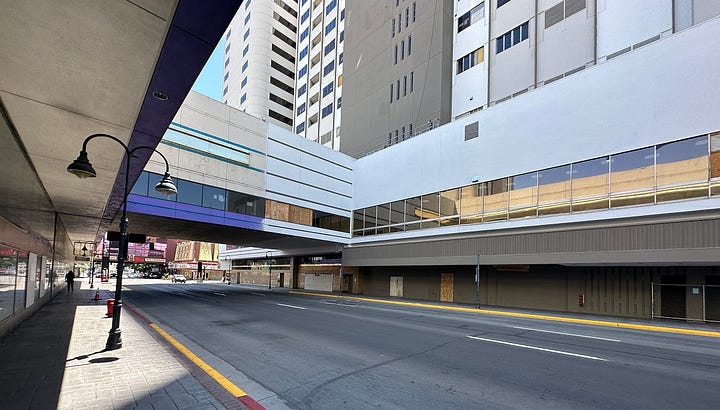
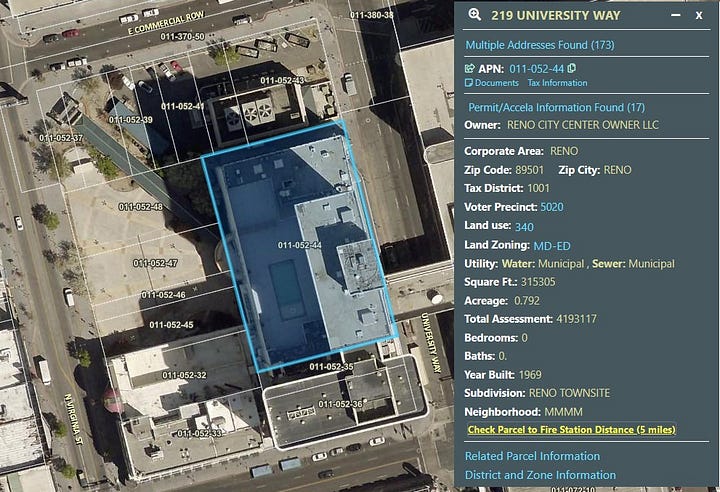
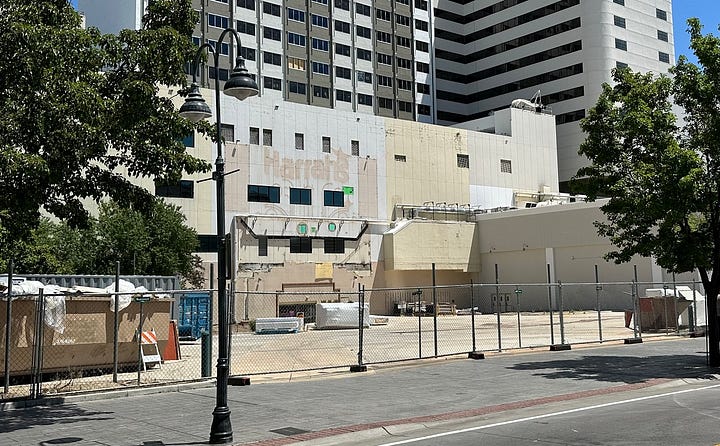
Technically, the Reno City Center property is still divided into multiple parcels, and the hatched area is part of a parcel that stretches west to the courtyard on the Virginia Street side (see above). At bottom right is a view of the courtyard taken last Friday. But the location on the site map doesn’t extend to the courtyard. So do these two licenses apply only to the hatched area on the site map, to the full parcel, or to the entirety of Reno City Center? And shouldn’t the staff report make that abundantly clear?
Adding further to the uncertainty is the description of the project in the RGJ: “For its first phase, the PKWY Tavern will have 197 gaming machines and 105 televisions for 24/7 sports viewing.” So what’s the second phase? On the company's website, PKWY Taverns are described as places to “Enjoy tabletop gaming including Poker, Blackjack, Keno, and Slots.” Is that projected for the Reno location, and if so, when? The other two restaurants that Fine Entertainment plans to open on site are BLVD and the Mint Bar. The website for BLVD identifies it as “Gaming | Cellar | Cocktails,” so clearly gaming is part of that concept, too—but again, precisely where? Would all this gaming be installed on bar tops or are we talking about banks of machines? Would they be integrated throughout the bar or in separate rooms? If the PKWY Tavern is intended to open to the courtyard that fronts Virginia Street, why doesn’t the site plan indicate that, and when would that entrance be opened to the public?
These questions are critical because Council is being asked to approve a new casino on a pivotal downtown block without having any clear indication where exactly it will be. Development of Reno City Center is clearly in flux, with recent changes in ownership, tenants, and potentially use of the towers. On June 9th, Chris Beavor said that his company, CAI Investments, had pulled out of the project because majority owner Gryphon had decided “to add a hotel component to the Reno City Center. Beavor reassured the RGJ that the multi-family housing component was still moving forward in the east tower. But his company is no longer involved, and there’s been no public statement about that from Gryphon. Back in February, another RGJ article said that an agreement had been struck with UNR to offer graduate student housing at the property by August 1st. But the link provided in that article leads nowhere, and UNR’s graduate housing webpage makes no mention of any such housing.
With major tenant Clear Capital out, CAI out, and hotel rooms in the offing, there’s little certainty of anything. If the entire project were envisioned as a hotel-casino, then perhaps identifying the specific locations where gaming would occur wouldn’t be absolutely necessary. But as long as it is being described as residential, even in part, then the specific location of those slot machines matters a great deal. And the City should know precisely what their actions would be enabling, where, and when.
Placemaking Implementation
Today’s second topic is placemaking. Under Item D.1, Council will consider spending up to $365,000 to begin implementing “Phase One” of Gehl’s recommendations from the Virginia Street Placemaking Study. Specifically, staff proposes to hire an urban designer to create plans to furnish sidewalks and open spaces (but not, it seems, to fund actual construction?) and also set money aside for grants to private property owners to enhance their building’s facades and interiors.
This is another item where I think our Councilmembers and residents should be asking a lot of questions, because the details here are critical in ensuring that these steps will be the most effective in getting the results we most want to see downtown. I participated in the Placemaking Study and support in its fundamental principles. But the biggest, most important revelation from that entire study was that 70% of the frontage along Virginia Street is inactive. What that tells us is that the main problem with Virginia Street isn’t that people don’t feel connected enough to it, or that it’s not safe enough to accommodate all the people walking, biking, or scooting around there, or even that there aren’t enough places to rest along the way. It’s that there is very little going on to attract people there in the first place, at all times of day.
Facade Improvements
Let’s talk about the Facade Improvement program first. Here, again, the devil is in the details, and the staff report gives frustratingly few of them. Under this plan, the City would set aside $1M for a “Re-Store Facade and Tenant Improvement Program.” The description claims this will “enhance the visual appeal, economic vitality, and overall livability of commercial areas of downtown” by providing “matching grants to property owners and business tenants for facade improvements and interior upgrades.” The grants could reimburse up to $50,000 each for interior and exterior improvements at a single property, ostensibly until the money runs out.
Now, I get the impetus to improve exteriors. Frankly, a lot of the buildings along Virginia Street and the surrounding blocks just don’t look good. That’s a primary reason that the City and Downtown Reno Partnership have been so keen on commissioning murals. But I’m not so sure there’s a direct line between improving the appearance of a building and attracting a viable long-term tenant or buyer—at least not without establishing some specific parameters that would commit a property owner to operating something viable there in order to receive public funds. It’s easy to get enamored with abstractions, so let’s offer some specific examples.
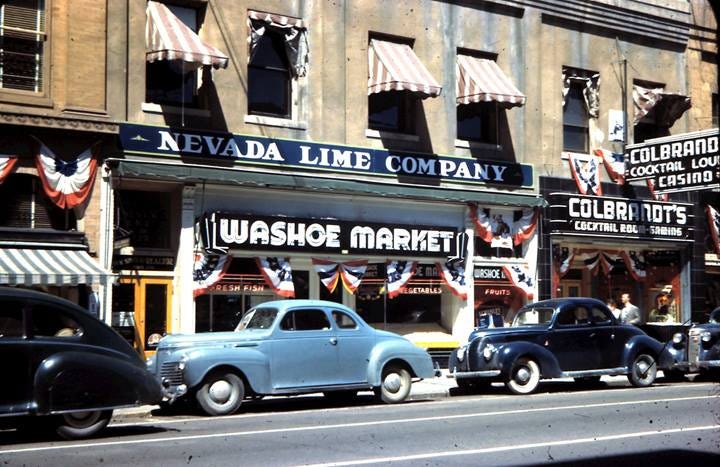
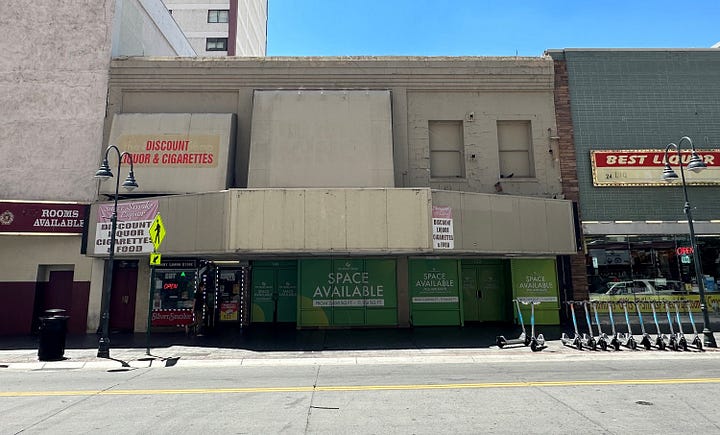
Above is the former Washoe Market property for lease at 141 N. Virginia Street. What is keeping this building from being leased? Is it the physical appearance? Let’s imagine that the property owner, Siegel Group, asks the City for $50K to help take that old marquee off the building, open up the second-floor windows, and restore the facade to its original historic appearance. That’s something I would love to see (if approved by someone knowledgeable of historic materials), but would it guarantee a viable tenant? Whitney Peak has multiple storefronts facing Virginia Street on the ground floor of their parking garage. They look great, but have stood empty for years. Why? I have no idea, but it’s not because they aren’t nice-looking storefronts.
However, if the public money is tied to a viable business plan and commitment to operate, then things begin to look more promising. Maybe the property owner has attracted a potential tenant, an independent business, that likes the location but can’t afford to improve it. So the City, property owner, and tenant draw up a plan that will allow the prospective tenant to devote more funds to inventory, or staffing, or whatever other supplies they need to open in the space. Without some kind of usage agreement, the City could be allotting funds to create a more attractive space that will remain vacant for decades. And while a lovely vacant space may be more attractive than an ugly vacant space, that’s not something that the public should be paying for.
Let’s also be sure not to remain focused on activating the ground floors alone. How about some incentive for property owners to revitalize and activate the vacant upper floors of older downtown buildings like these, which appear throughout downtown?
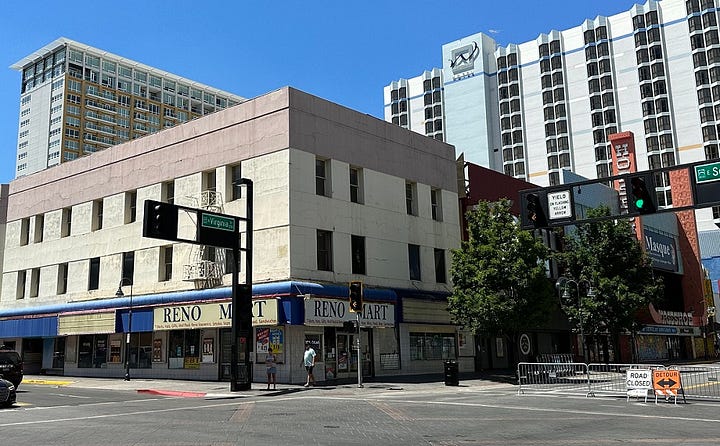
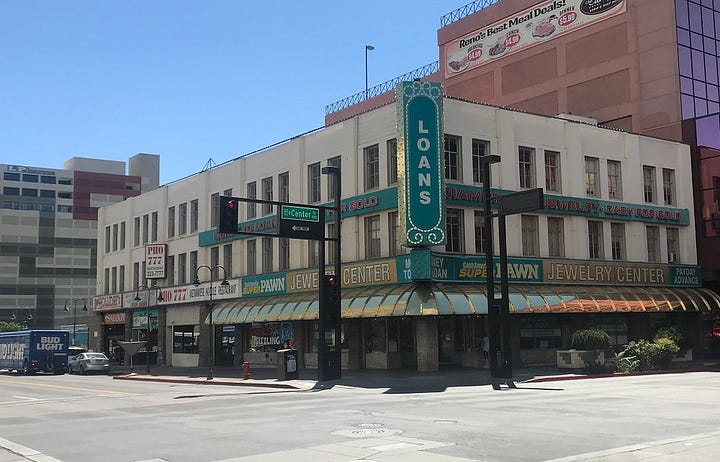
On the left is the Byington building at the northwest corner of Second and Virginia. On the right is the E.C. Lyons building at 102 East 2nd Street. Both were once highly coveted office addresses, but the upper floors now appear vacant. But what if they were fully occupied again, restoring that density of use and people that a city needs in order to thrive? Could they be offices again? Apartments? Studios or workspaces?
Last week, the City posted a job opening for a Property Analyst. Among other things, this new staff person would “analyze and evaluate land, buildings, and infrastructure within the Redevelopment Area. The position is responsible for determining the highest and best use for each site, creating redevelopment strategies and plans, managing projects for the Redevelopment Agency, preparing requests for processes (i.e. proposals, information, qualifications), negotiating with developers, and ensuring that projects are completed on time and within budget.”
This is honestly something I thought the Downtown Reno Partnership would do years ago—survey all properties in the downtown core and evaluate their current and potential uses, and try to attract new tenants or buyers to them. In any case, that’s the perfect accompaniment to a facade/interior improvement grant program, but their analysis should come FIRST. After that downtown inventory, the City could solicit and review proposals by applicants with a vetted business plan and commitment to utilize part or all of a building within set parameters formulated by the City in advance. Without robust requirements like that, it seems premature to approve the dedication of $1 million in public funds to helping private property owners improve buildings that may linger for years as more attractive but equally hollow shells.
Locomotion Plaza 2.0
I’ve had issues with Locomotion Plaza from the beginning—not because of its mural, but because the way this plaza has been implemented is completely at odds with the original vision as described in the fantastic, comprehensive, and almost entirely forgotten 2007 ReTRAC corridor study plan. This is a fenced-off concrete (albeit colorful) slab, not the proposed greenway opening to surrounding residential and retail space. Even the plants are surrounded by their own miniature fences. Gehl’s renderings depict yoga, a food truck, and people happily sitting at a table, and the theory is that shade, tables, and programming will active this space enough to justify fencing off this large slab surrounded by the Eldorado’s loading dock, Whitney Peak’s parking garage, and its valet dropoff lane. What do you think?
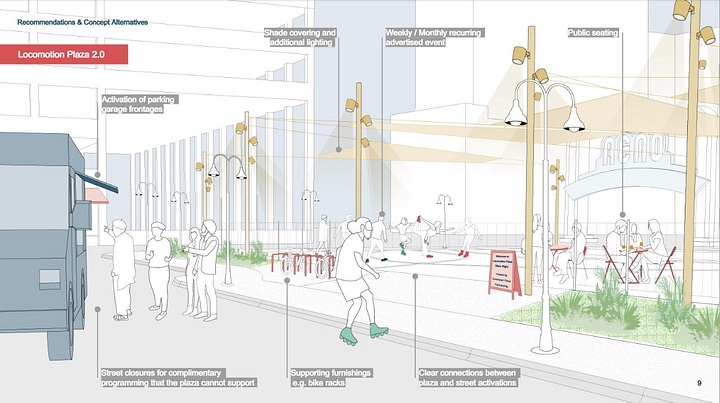
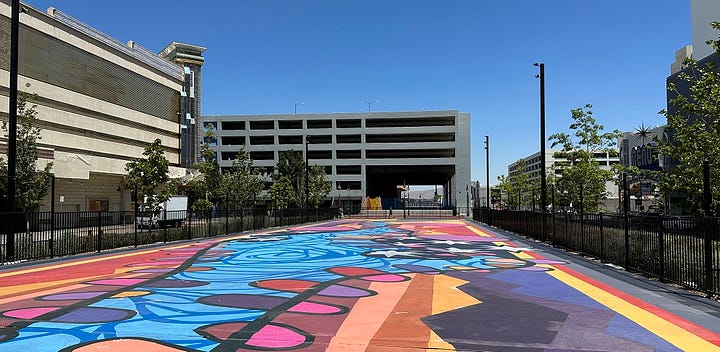
The ROW “Placita”
This next item proposes to “Source and implement seating elements, movable by forklift, and including wayfinding with walking distances to districts and destinations” on the parcel owned by Caesars Entertainment that leads to the west entrance to the Reno Ballroom. The City is pitching this as a potential model for “activation of privately owned public space” (also known as POPS). So why should the City pay for the design and installation of seating and wayfinding on a lot owned by Caesars Entertainment? The idea behind POPS is that they can increase the amount of public space in dense urban areas by arranging with a private landowner to allow public use of a privately-owned space as though it were a public park or plaza.
But here’s the thing: Reno doesn’t need this space to be open. And even if we did, it’s already been open for decades. Does it need seating? It’s literally one block north of one City-owned public space, Locomotion Plaza (where seating is also being proposed) and across 4th Street from the old CitiCenter site, another public space currently operating as a plaza.
The remaining funds would fund design of public seating on every block along Virginia Street along with more wayfinding, potentially more trees, and event infrastructure. I see that Ky Plaskon of the Truckee Meadows Bicycle Alliance has just written an opinion piece for This is Reno suggesting that the City prioritize long-awaited micromobility infrastructure over public seating. Bob Conrad just published his own piece about the projected expenditures, too. Definitely give both a read.
Lastly, with item G.1, Council could appoint three people to the Planning Commission. Candidate names are here with applications attached separately. If you want to comment on any of these items, consult the top of the agenda. I strongly encourage you to do so; you are the “public” in the public interest and you matter.
As always, you can view this and prior newsletters on my Substack site and follow the Brief (and contribute to the ongoing conversation) on Twitter, Facebook & Instagram. If you feel inspired to contribute to my efforts, my Venmo account is @Dr-Alicia-Barber and you can mail checks, if you like, to Alicia Barber at P.O. Box 11955, Reno, NV 89510. Thanks so much for reading, and have a great week.




I know I'm behind on a lot these topics however, isn't the former Harrah's supposed to be apartments with businesses on the bottom, maybe a small boutique hotel, no gaming if I remember? I know plans change but seriously do we need more gaming? Just like the purposed site on the corner of Virginia and Kietzke.
The downtown casino area does need help. It needs more attention from the Police and social services. There needs to be "beat cops" patrolling with a person representing social services (Cares Campus, Catholic Charities, 211, Nevada Hopes, Access to Healthcare NV, etc). Or at least an office there to reach the people where they are.
I honestly can't believe there isn't a small substation with Police, EMT/First-Aid Responders. When I worked security in one of the casinos years ago it was a sh!t show trying to get patrons to understand we don't call the cops to file a report for a stolen phone. Or if a patron needed more than basic first aid that we were allowed to provide but didn't need an ER, we'd end up taking them to the ER at St. Mary's.
I know there is an axillary force, even a senior citizen axillary, could even check with CERT for holidays and large events. These are the people that could man the station on a voluntary basis to help people file a report leaving the police to patrol and respond to calls or events.
Also, driving downtown stinks. There needs to be better flow, like one way streets. This allows for more street parking and bike lanes. Thinking 1st to 5th or 6th, Sierra to Lake. It's only going to get worse with the new building going on at Lake & 1st. I mean Virginia is only lane each direction anyway. During the holiday season or large events, traffic is horrible.
I have the ides of off street parking garages with a trolleys that go from Plumb to UNR. Paid for with money from the parking garages. Show your ticket and ride. Or pay say 25 cents, donation, or buy a pass for a week or month.
Sorry for the long comment however, this seems like a great place to air my ideas.